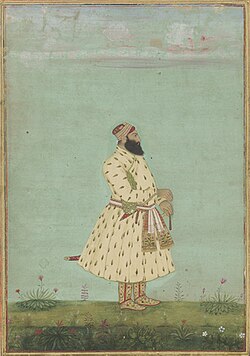Safdarjung's rebellion: Difference between revisions
No edit summary Tags: Mobile edit Mobile web edit Advanced mobile edit |
Tags: Mobile edit Mobile web edit Advanced mobile edit |
||
| Line 26: | Line 26: | ||
In response, on 13 May 1753, Ahmad Shah Bahadur dismissed Safdarjung as Wazir (prime minister) and appointed Intizam-ud-Daulah in his place, with [[Imad-ul-Mulk]] as [[Bakhshi (Mughal Empire)|Mir Bakshi]] (chief military officer). Safdarjung retaliated by declaring a eunuch as a rival emperor under the name Akbar Ādilshāh and appointing himself as Wazir and Sarbuland Khan as Mir Bakshi.<ref name="JP" /> | In response, on 13 May 1753, Ahmad Shah Bahadur dismissed Safdarjung as Wazir (prime minister) and appointed Intizam-ud-Daulah in his place, with [[Imad-ul-Mulk]] as [[Bakhshi (Mughal Empire)|Mir Bakshi]] (chief military officer). Safdarjung retaliated by declaring a eunuch as a rival emperor under the name Akbar Ādilshāh and appointing himself as Wazir and Sarbuland Khan as Mir Bakshi.<ref name="JP" /> | ||
==Battle== | |||
Between 9 May and 4 June 1753, numerous skirmishes took place, largely favoring Safdarjung. However, the arrival of [[Najib ad-Dawlah|Najib Khan]] and his [[Rohillas|Rohilla]] forces to aid the emperor changed the tide. A significant assault on Delhi's walls on 5 June failed, marking the beginning of Safdarjung's decline. By 7 November, Safdarjung had suffered several defeats and was pushed back to [[Ballabgarh]]. | |||
One of the pivotal moments for Safdarjung was the death of his favored general, Rajendra Gossain, from a musket shot. Devastated, Safdarjung refused to enter the battlefield personally, which demoralized his troops. The Jats and [[Qizilbash]]es on Safdarjung's side continued to fight against the [[Marathas]] and the imperial forces, but the morale of his men weakened, leading to defections to the emperor's camp. | |||
Meanwhile, the emperor received reinforcements from several regional rulers, and the Marathas exploited the situation by attacking Safdarjung's rear, looting his camp. Suraj Mal, recognizing the deteriorating situation, entered negotiations with Intizam-ud-Daulah. Desperate for peace, Ahmad Shah Bahadur sought the assistance of Sawai [[Madho Singh]] of [[Jaipur]]. Madho Singh successfully mediated a peace treaty between the emperor and Safdarjung. As a reward, the emperor granted Madho Singh the fort and district of [[Ranthambore Fort|Ranthambore]]. | |||
Safdarjung and the other warlords eventually left the capital. However, the conflict left the emperor financially strained, contributing to his eventual dethronement six months later.<ref name="JP" /> | |||
==Reference== | ==Reference== | ||
{{reflist}} | {{reflist}} | ||
Revision as of 21:17, 22 June 2025
| Safdarjung's rebellion | |||||||
|---|---|---|---|---|---|---|---|
 | |||||||
| |||||||
| Belligerents | |||||||
|
|
| ||||||
| Commanders and leaders | |||||||
|
Sayyid Salabat Khan Zulfiqar Jang |
| ||||||
The Safdarjung's rebellion occurred on 10 March 1753 during the waning years of the Mughal Empire. It was characterized by a conflict between Safdarjung, the Nawab of Oudh, and the Mughal emperor Ahmad Shah Bahadur, alongside his court factions.
Background
Tensions between Safdarjung and Intizam-ud-Daulah, another prominent noble, had been escalating since March 1753. Emperor Ahmad Shah Bahadur lacked the authority to control these powerful nobles. Although the emperor and his mother initially ordered Safdarjung to return to his governorship in Oudh, Safdarjung delayed his departure. Eventually, on 26 March 1753, he left Delhi but, instead of returning to Oudh, set up camp just outside the city with his army. Safdarjung wavered between allying with the emperor or taking action against him.
For a time, both sides hesitated to act, but Safdarjung's position shifted after receiving reinforcements from Suraj Mal, the Jat ruler, and Salabat Khan. Gaining confidence, Safdarjung encouraged the Jats to loot Old Delhi.[4] On 9 May 1753, the Jats plundered the city, burning several areas. Many civilians fled to the fortified New Delhi, while the Jats extracted lakhs of rupees from the city's outskirts.[1]
In response, on 13 May 1753, Ahmad Shah Bahadur dismissed Safdarjung as Wazir (prime minister) and appointed Intizam-ud-Daulah in his place, with Imad-ul-Mulk as Mir Bakshi (chief military officer). Safdarjung retaliated by declaring a eunuch as a rival emperor under the name Akbar Ādilshāh and appointing himself as Wazir and Sarbuland Khan as Mir Bakshi.[1]
Battle
Between 9 May and 4 June 1753, numerous skirmishes took place, largely favoring Safdarjung. However, the arrival of Najib Khan and his Rohilla forces to aid the emperor changed the tide. A significant assault on Delhi's walls on 5 June failed, marking the beginning of Safdarjung's decline. By 7 November, Safdarjung had suffered several defeats and was pushed back to Ballabgarh.
One of the pivotal moments for Safdarjung was the death of his favored general, Rajendra Gossain, from a musket shot. Devastated, Safdarjung refused to enter the battlefield personally, which demoralized his troops. The Jats and Qizilbashes on Safdarjung's side continued to fight against the Marathas and the imperial forces, but the morale of his men weakened, leading to defections to the emperor's camp.
Meanwhile, the emperor received reinforcements from several regional rulers, and the Marathas exploited the situation by attacking Safdarjung's rear, looting his camp. Suraj Mal, recognizing the deteriorating situation, entered negotiations with Intizam-ud-Daulah. Desperate for peace, Ahmad Shah Bahadur sought the assistance of Sawai Madho Singh of Jaipur. Madho Singh successfully mediated a peace treaty between the emperor and Safdarjung. As a reward, the emperor granted Madho Singh the fort and district of Ranthambore.
Safdarjung and the other warlords eventually left the capital. However, the conflict left the emperor financially strained, contributing to his eventual dethronement six months later.[1]
Reference
- ↑ 1.0 1.1 1.2 1.3 Sarkar, Jadunath (2007). Fall of the Mughal Empire:vol one. Orient Black Swan. pp. 236–249.
22 miles south of Delhi, as far as Ballabgarh, was wrested by the emperor's men, and finally on 7th November Safdar Jang accepted defeat.
- ↑ The Army Quarterly and Defence Journal, Volume 114. West of England Press. 1984.
- ↑ Chopra, Prabha (1976). Delhi Gazetteer. The Unit. p. 1165.
- ↑ Hasan, M. (2002). HISTORY OF ISLAM (2 Vol. Set). Adam Publishers. ISBN 978-8-174-3-50190.